A jubilee is a special holy year of grace and pilgrimage in the Catholic Church. All Catholic faithfuls are encouraged to participate in pilgrimages, visit sacred places and engage in works of mercy. The jubilee typically takes place once every 25 years, though the pope can call for extraordinary jubilee years more often, such as in the case of 2016 Year of Mercy.
Tradition dictates that each jubilee is proclaimed through a papal bull of indiction, a document written in Latin that bears the seal of the pope. Pope John Paul II proclaimed the Jubilee of the year 2000 with the bull Incarnationis mysterium, meaning "the Mystery of the Incarnation." Pope Francis proclaimed the Jubilee Year of the year 2025 with the papal bull
Spes non confundit, meaning "Hope Does Not Disappoint". It declared that the Jubilee Year will officially begin with the opening of the Holy Door of St. Peter's Basilica on Christmas Eve 2024. The 2025 Jubilee will officially conclude with the closing of the Holy Door in St. Peter's Basilica on Jan 26, 2026.
 |
| On Christmas Eve 2024, Pope Francis opened Holy Door of St. Peter's Basilica, launching the "Jubilee of Hope." |
A significant aspect of the Jubilee Year is an invitation to make a pilgrimage to the Vatican in Rome. The Vatican anticipates over 32 million pilgrims to visit Rome for the Jubilee. For Catholics around the world, the Holy Doors represent the most visually significant symbol of the Rome jubilee. The Holy Doors in Rome are at St. Peter's Basilica, San Giovanni in Laterano, Santa Maria Maggiore, and Saint Paul's Outside the Walls. Passing through the Holy Doors in Rome during a Jubilee year holds profound spiritual significance; it is a time of special grace and indulgence, offering pilgrims a chance to experience spiritual renewal and forgiveness.
For those unable to travel to Rome, the Church designates local holy doors at cathedrals or special churches worldwide during a Jubilee year. Pilgrims who visit these designated churches will also have the opportunity to receive a plenary indulgence, under the usual conditions: sacramental confession, Eucharistic communion, and prayer for the intentions of the Holy Father. In Nov 2024, the Catholic Bishop's Conference of the Philippines (
CBCP) released the list of Jubilee Churches in the Philippines. All the 86 ecclesiastical jurisdictions in the Philipines have designated churches in their respective areas, ranging in number to as low of 2 in the Diocese of Kidapawan and 31 in the Diocese of Daet.
In the cusp of senior citizenship, the Bicolano Penguin (BP) has not participated yet in a pilgrimage during a Jubilee year in my lifetime. Not in 1975, 1983, 2000 nor in 2016. Mainly because of not knowing the profound significance of the Jubilee year. Now that I know of it, the BP is most eager to join a pilgrimage on a jubilee year.
Thank God the parish where I serve as a lector, the Ascension of Our Lord Parish (
AOLP), organized a parish pilgrimage with the theme:
"A Community in Mission: Proclaiming the Lord's Ascension as aBeacon of Hope for God's People." A week before the parish pilgrimage date, the BP registered and come the early morning of May 17 was among the 48 AOLP parishioners, including our parish priest, Fr. Ricky Pacoma, embarked on the journey of hope.
The AOLP pilgrimage covered 8 jubilee churches, three in the Diocese of Paranaque and five in the Archdiocese of Manila. Not all churches designated as Jubilee churches are identical. The 8 jubilee churches encompass a wide variety of locations and offer varied flavors of experiences. From major cathedrals to local parishes, all united by their role as places of spiritual renewal during the Jubilee year.
 |
| Before 5:30am, the AOLP pilgrims left the Goodwill Subdivision and were on their way to the 1st destination of 8 jubilee churches. |
Diocesan Shrine and Parish of St. Joseph
Located in the neighboring city of Las Pinas, the Diocesan Shrine of St. Joseph is the nearest church to AOLP in terms of distance, thus the 1st church we visited. It is the home of the world-famous Las Pinas Bamboo Organ. The Parish of St. Joseph was established in 1795 by the Augustinian Recollects. In 1816, when the church was almost complete, the parish priest (Fr. Diego Cera) started building the organ made of bamboo and completed the instrument in 1824. In 2013, this church was declared a Historic Landmark by National Historical Institute.
.jpg) |
| AOLP pilgrims entering the door of the Bamboo Organ Church |
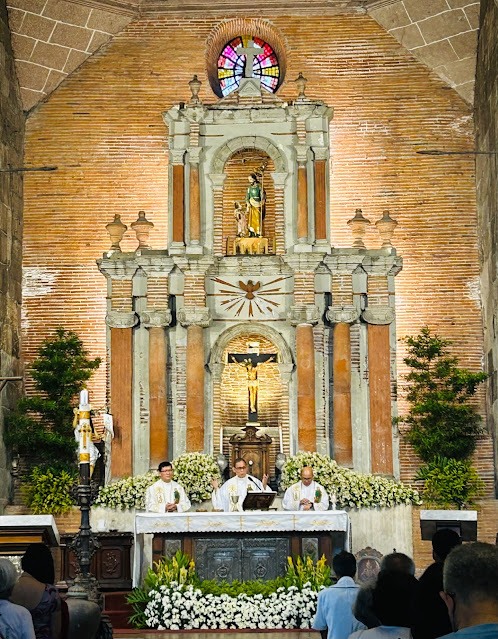 |
| The AOLP Pilgrims arrived just in time for the 6am mass. Our AOLP parish priest Fr. Ricky Pacoma joined 2 priests in celebrating the Holy Mass. |
 |
| After the Holy Mass, Fr. Ricky led the praying of the Jubilee Prayer and gave guidance to the pilgrims in our conduct as we visited the church. |
 |
| First time for me to visit and see up close the world-famous Las Pinas Bamboo Organ. Truly, magnificent. |
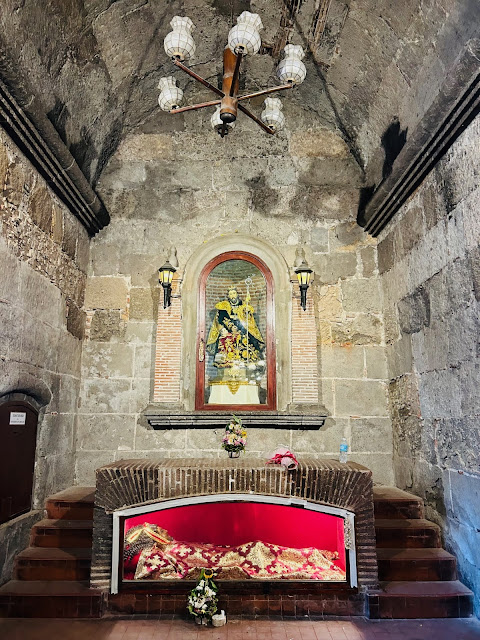 |
| Inside the Las Pinas Bamboo Church is a small side room housing the Santo Entierro. Reverence is in the air. |
 |
| At the door of the church, parish volunteers of the Las Pinas Bamboo Church were on hand to stamped the jubilee pilgrim booklets which served as passports. |
 |
| Beside the church is the Bamboo Organ Museum. |
.jpg) |
| The Bamboo Organ Museum housed many religious and historic items. My camera was drawn to taking photos of the old paintings of the Sagrada Familia (Holy Family). |
 |
| First time for me to see a sculpture of the Holy Family with the child Jesus holding a cross. |
 |
| The sunrays kissing the Las Pinas Bamboo Church in all its splendor. The architectural style of this church is Earthquake Baroque. |
St. Andrew Cathedral and Diocesan Shrine of Nuestra Senora del Buen Suceso
Just a couple of kilometers away on the same road, the St. Andrew Cathedral is the 2nd church we visited. One of the oldest churches in the Philippines, it was established in 1580 by the Augustinians. It is the seat of the Diocese of Paranaque which comprises the cities of Las Pinas, Muntinlupa and Paranaque. In 1625, the Augustinians enthroned in the parish the Nuestra Senora del Buen Suceso (Our Lady of Good Success). In Sept 2000, the image of the Nuestra Senora del Buen Suceso was canonically crowned as the Patroness of the City of Paranaque
 |
| AOLP pilgrims entering the door of St. Andrew Cathedral |
 |
| The main altar at the St. Andrew Cathedral. The image of Nuestra Senora del Buen Suceso is at the center with St. Joseph (carrying the Child Jesus) to the right of Our Lady and St. Andrew (with the distinctine X Cross) to the left. |
 |
A closer look of the image of Nuestra Senora del Buen Suceso at the altar. This official replica was restored by renowned Ecclesiastical Arts master craftsman Thomas Joven. The image of the Lady of Good Event or "Nana Ciso" to the locals is that of a wooden head, hands and Child Jesus of dark hue. The image is done in a de bastidor style and is meant to vested with real clothing.
|
 |
| Group photo of the AOLP pilgrims with Fr. Ricky. Photo courtesy of The Cathedral Parish of St. Andrew. |
 |
| After praying in front of the main altar of St. Andrew Cathedral, the AOLP pilgrims were invited to go up the camarin (a small chapel/shrine) behind the altar. A parish volunteer of St. Andrew Cathedral conducted a tour of the historic religious items. |
 |
| The Diocesan Shrine of Nuestra Senora del Buen Suceso has a unique tradition where devotees go under the cape to pray and seek blessings. With Fr. Ricky holding the cape, the AOLP pilgrims participated in the tradition. |
 |
| Group photoof the AOLP pilgrims inside the camarin of St. Andrew Cathedral. |
.jpg) |
| Side altar in St. Andrew Cathedral. Notice something out of the ordinary. There is an image of a saint without a head. |
 |
| The name of the headless saint is San Dionisio (St. Denis). Believed to be the first bishop of Paris, St, Denis was martyred during the persecution of Christians by Roman emperor Valerian in 258. After St. Denis was beheaded by Valerian steel, it is said that he was able to pick up his head and continued to preach the Gospel. The devotion to San Dionision de Paranaque or "Tata Dune" to the locals, is observed by the people of Barangay San Dionisio and neighboring barangays due to numerous miracles attributed to his intercession. |
.jpg) |
| In the shadow of the bell tower of St. Andrew Cathedral, AOLP pilgrims line up to have their jubilee passports stamped. |
 |
| Photo with a pair of the official mascots of the Catholic Church's Jubilee Year 2025. There are 7 and in the photo are Sky and Fe. |
 |
| Architecture-wise, the St. Andrew Cathedral features a classic Baroque style. It comes with a simple yet distinctice facade. Instead of the traditional cross, the pediment of the cathedral features a triangle shape. |
National Shrine of Our Mother of Perpetual Help
Still in the Diocese of Paranaque, the 3rd jubilee church we visited is the
National Shrine of Our Mother of Perpetual Help or more commonly known as Baclaran Church. The shrine is administered by the Congregation of the Most Holy Redeemer (Redemptorists) and under the territory of the Santa Rita de Cascia Parish. When the early Redemptorists settled at Baclaran in the 1930s, they requested that the church besides their convent will not become a parish but a mission station in order to free them from sacramental work, except for the Eucharist and Penance. With a full seating capacity of 2,000 (but as many as 11,000 including those standing can fit), it is one of the largest Marian churches in the Philippines. A very popular church for prayer devotion, the National Shrine of Our Mother of Perpetual Help is open 24 hours 7 days a week (24/7). In 2023, the Baclaran Church was declared an important Cultural Property by the National Museum of the Philippines.
 |
| According to one of our hosts in the Baclaran Church, Mama Mary's icon was just brought down that morning and the AOLP pilgrims were the first ones to touch the icon. |
 |
| Group photo of the AOLP pilgrims with the icon. Photo courtesy of the National Shrine of Our Mother of Perpetual Help. |
 |
| Shopping for Jubilee Pilgrimage souvenirs at the Perpetual Help Center and Souvenir Shop. |
San Fernando de Dilao Parish Church
The 4th jubilee church we visited is the San Fernando de Dilao Parish Church, more commonly known as Paco Church. It is the first church in our AOLP pilgrimage list that is in the Archdiocese of Manila. Its history is a testament to the resilience and outright doggedness of the priests and the parish community. The first Paco church was built made of nipa by the Franciscan priests in 1580 and since that time up to the present, it has endured 4 burnings by rampaging mobs/invaders (1603, 1762, 1899 & 1944), 2 earthquake destruction (1852 & 1880), and 1 typhoon devastation (1892). Royal drubbing for a church dedicated to a royalty. On Feb 2012, the Paco Church was designated as pro-Cathedral of Manila until structural renovations of the Manila Cathedral were completed on April 2014.
 |
| The facade of the Paco Church, flanked by tall twin belfries, possess a neoclassical style of structure. The Corinthian columns of the first and second levels of the church plus the triangular pediment give the facade the classic character. |
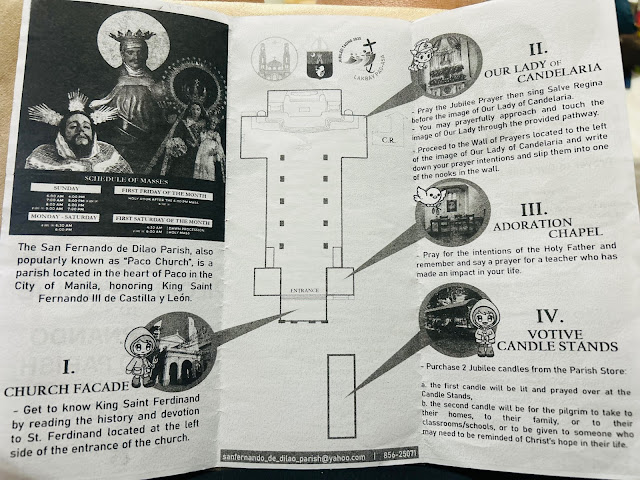 |
| The Paco Church parish volunteers provide a pilgrim's guide to the AOLP pilgrims. The guide included 4 steps in the pilgrimage visit to Paco Church. |
 |
1st step in the 4-step guide is get to know more about San Fernando. The Paco Church honors King Fernando III who was King of Castile from 1217 and 1252 and of Leon from 1230 to 1252 and conqueror of the Muslim cities of Cordoba (1236), Jaen (1246) and Sevilla (1248). He was canonized a saint in 1671 by Pope Clement X. San Fernando is considered the patron saint of engineers.
|
 |
| The dome of Paco Church with Latin inscriptions similar in style to Saint Peter's Basilica in Rome. |
 |
| A notable longstanding custom in Paco Church is the devotion to Nuestro Santo Padre de Jesus del Sepulcro. An image of the Santo Entierro is encased in a special wood and glass casket at the left part of the Paco Church. |
 |
| 2nd step is pray the Jubilee Prayer and then sing Salve Regina before the image of Our Lady of Candelaria which is located at the right side of Paco Church. |
 |
| 4th step is light a candle at the Votive candle stands in the courtyard of Paco Church. |
National Shrine of Our Lady of the Abandoned
The 5th Jubilee Church we visited is the National Shrine of Our Lady of the Abandoned. Being located in the Sta Ana district of Manila, it was originally and still known as the Sta. Ana Church. Its site was established by the Spanish Franciscan Missionaries in 1578, the first Spanish settlement established outside of Intramuros. Originally of nipa and bamboo make, construction of a larger church in stone begun around 1720 and finished in 1725. In time, the church became known as Our Lady of the Abandoned Parish, as it houses the centuries old and miraculous image of Nuestra Senora de los Desamparados, which was brought from Valencia, Spain. In 1977, major restoration was undertaken by the National Artist Juan F. Nakpil to bring out the church's orginal appearance for the town of Sta. Ana's 400th Anniversary. The Sta Ana Church houses two National Cultural Treasures declared by the National Museum of the Philippines: the Sta Ana Site Museum and the Camarin dela Virgen.
.jpg) |
| The Sta, Ana Church depicts a Baroque style structure, utilizig adobe blocks in its wall surface finish to give an impression of massiveness. |
 |
| The retablo or the main altarpiece is in churrigueresque style, characterized by heavy ornamentation. It has 13 niches. The tabernacle occupied the central niche of the lower level flanked by 4 Fransciscan saints, namely Bonaventure, Peter of Alcantara, Bernardino of Siena and Clare of Assissi. The central niche of the second level is occupied by Our Lady of the Abadoned at the center. The upper level niches contained the images of Anne (the mother of Blessed Virgin Mary). |
 |
| The AOLP pilgrims were able to go up to the Camarin dela Virgen (Dressing Room of the Virgin) which is a small chapel located behind the niche of the Our Lady of the Abandoned on the 2nd tier of the Retablo. |
 |
| Quite visually impressive and culturally significant inside the Camarin are the paintings on the ceiling and entrance which are believed to be as old as the camarin and the churh itself (circa 1700s). These paintings belonged to the Estampita Age of Filipino-Spanish art. |
 |
| The central panel of the ceiling paintings shows the Holy Trinity and the kneeling Virgin Mary. The central panel is surrounded by scenes from the lives of Mary and Jesus, from Mary's betrothal to Joseph to the Baptism of Jesus. |
 |
| When the AOLP pilgrims visited Sta. Ana Church, it was almost high noon with the outside of the church being very hot and humid. Some of the pilgrims took the time to rest in the cool shade the church provided and have a conversation with fellow pilgrims on topics both mundane and spiritual . |
 |
| On our way out of Sta. Ana Church, we passed by the Santo Entiero image with the image of Mater Dolorosa by its side. |
National Shrine of the Sacred Heart of Jesus
Still in the Archdiocese of Manila, the 6th Jubilee Church we visited is the National Shrine of the Sacred Heart of Jesus. It is located in Makati, specifically in San Antonio Village which is just a stone's throw away from the bustling Ayala Business District - the beating financial heart of the Philippines. While the AOLP pilgrims have visited already churches started by Augustinians (Las Pinas Bamboo Church & St. Andrew Cathedral), Franciscans (Sta. Ana Church & Paco Church), and Redemptorists (Baclaran Church), the National Shrine of the Sacred Heart of Jesus (NSSHJ) is the first church in our AOLP Jubilee Pilgrimage that is inspired and guided at the start by a Jesuit. Back in the mid 1950s, Fr.
Fr. Pedro Verceles, S.J. was the national director of the Apostleship of Prayer (AP) which is an international Catholic organization that actively promotes the devotion to the Sacred Heart. Fr. Verceles was one of the priests that celebrated the Holy Mass at the small chapel started by the San Antonio Village Women's Club. Thru time, the Jesuit priest kindled the community's devotion to the Sacred Heart and eventually the San Antonio Village Apostleship of Prayer Center, Inc. (SAVAPCI) was incorporated in the mid-1960s. Eventually, the SAVPCI community was converted into a parish in the early 1970s.
 |
| The parish volunteers who warmly welcomed the AOLP pilgrims provided us a guide list showing us the sequence of activities for our visit to the NSSHJ. |
 |
| AOLP pilgrims entering the NSSHJ. The Sacred Heart shrine is an artistic fusion of post modern and classic interiors thoughtfully designed to complement elegance and accentuate comfort with solemnity of worship. |
 |
| The 5th step in the guide list encourages the pilgrim to write a personal resolution for 2025 on post-it notes and post in on the wall. The AOLP pilgrims enthusiastcially went about this 5th step. |
 |
| The Personal Resolution Wall in the NSSHJ. An explosion of color just like in a kaladeiscope. It symbolizes transformation, change, and the infinite possibilities within the human experience. |
National Shrine of Our Lady of Guadalupe
The 7th Jubilee Church we visited is another National Shrine located in Makati, in the district of Guadalupe Nuevo near EDSA. It is a national shrine to Our Lady of Guadalupe, the "Celestial Patroness of the Philippine Islands". Such a distinction for Our Lady of Guadalupe was made official per a Papal Bull issued by Pope Pius XI in 1935. In 1951 the parish in Guadalupe Nuevo was established by Archbishop Gabriel Reyes. In 2002, Archbishop Jaime Cardinal Sin issued a decree making the parish as the Archdiocesan Shrine of Our Lady of Guadalupe. In 2010, during the time of Archbishop Emeritus Gaudencio Cardinal Rosales, it was elevated into a National Shrine.
 |
| The facade of the National Shrine of Our Lady of Guadalupe (NSLG). |
 |
| Full of energy, the parish volunteer from NSLG gave a welcome remarks upon the arrival of the AOLP pilgrims. She then proceeded to expertly guide us to several steps of the pilgrimage experience in NSLG. |
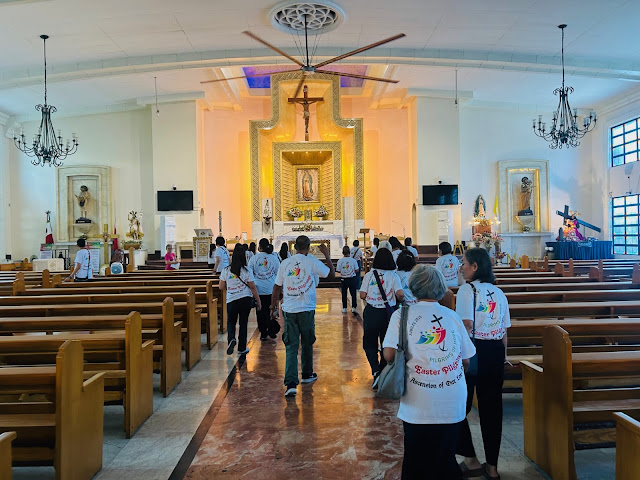 |
| AOLP pilgrims entered the church and proceeded in front of the Jubilee Cross to pray the Jubilee Prayer |
 |
| An image of San Juan Diego on the left side of NSLG. It is said that on the fourth apparition , the Blessed Virgin Mary ordered Juan Diego to collect roses from the Tepeyac Hill and bring them to the local bishop. In his audience with the bishop on that day, Juan Diego opened his tilma (cloak), letting dozens of roses fall on the floor and revealing the image of Mary imprinted on the inside of the cloak - the image that is now venerated in the Basilica of Guadalupe. |
 |
| A must visit in the NSLG is the Capilla De La Venerada which is at the back of the main altar of the church. |
 |
| One of the religious items in the Capilla De La Venerada is a small rock from the Tepeyac Hill. |
 |
| Group photo of AOLP Pilgrims inside the Capella De La Venerada. The altar table is the same altar upon which Pope Saint Paul VI and Pope Saint John Paul II presided over the Eucharist during their Papal masses in the Philippines. |
Royal & Concillar Seminary of San Carlos
The 8th and last Jubilee Church we visited is the chapel at the Royal & Concillar Seminary of San Carlos. The San Carlos Seminary is called "Concillar" because its foundation and purpose were inspired by the Council of Trent (1545-1563). The Council of Trent was the Church's zealous response to the signs of the times during the Protestant Reformation. The Council of Trent mandated the establishment of seminaries to ensure a proper formation for future priests. King Philip V of Spain, following the council's prescription, signed a royal decree ordering the foundation of the seminary in the Philippine islands. The seminary was called San Clemente (after the reigning Pope of the time), then San Felipe (in honor of the founding King), and finally in 1786 San Carlos Borromeo (after the saintly bishop of Milan who directed the Council of Trent).
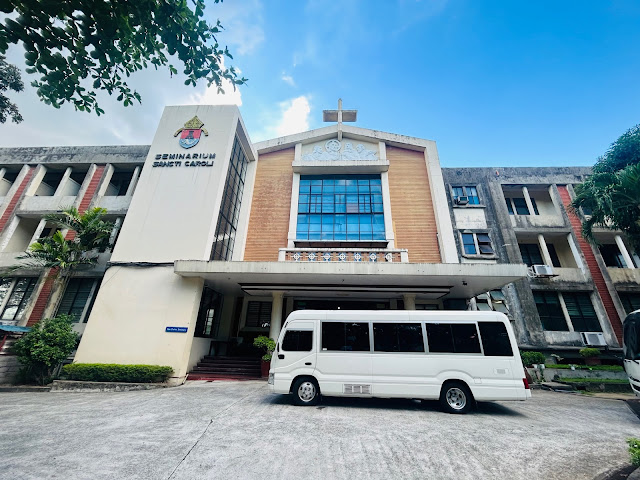 |
| The coaster transporting AOLP pilgrims arrives at the San Carlos Seminary. |
 |
| AOLP pilgrims entering the high-ceiling chapel of the San Carlos Seminary |
 |
| In the celebration of the Holy Mass, Fr. Ricky was joined by a seminarian from the Diocese of Paranaque. |
 |
| Quite a homecoming for Fr Ricky as he had his priestly formation in the San Carlos Seminary. In his homily, Fr Ricky shared that it was his 1st time to celebrate mass in this chapel. |
 |
| The chapel in the San Carlos Seminary is designated as a pilgrim for Bishops, Priests, Deacons, Seminarians, Religious, Missionaries. Inside the chapel are banners proclaiming this. |
 |
| In one of the hallways near the chapel is a big portrait of Jaime Cardinal Lachica Sin, the 30th Catholic Archbishop of Manila. Cardinal Sin is considered a prominent example of servant leadership not only for the Catholic faihtful but for the Filipino people. |
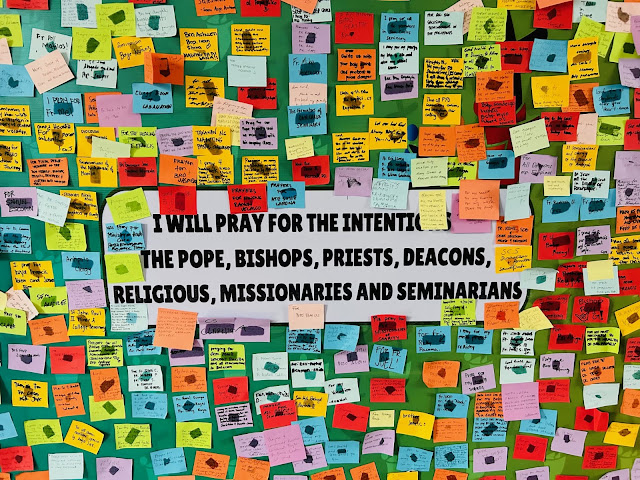 |
| Prayer wall outside the chapel of the San Carlos Seminary. It is a visible representation of a collective prayer life, allowing people to support each other. |
There you have it. All 8 Jubilee Churches which us, the AOLP pilgrims have the privilige and good fortune of visiting on that 3rd Saturday of May. The 2025 Jubilee Year Pilgrimage of the AOLP community certainly did not disappoint. By all counts, the experience was and is meaningful. For this, we have the organizing team to thank for. I inquired from Pilar Lopez, the head of the Parish Pastoral Council in AOLP about the composition of the organizing team and this was her reply.
 |
| The AOLP organizing team for the 2025 Jubilee Pilgrimage (May 17) |
God bless all those who made the AOLP Parish Pilgrimage possible. God bless too all the AOLP parishioners who participated last May 17. The experience we will all cherish the rest of our lives.
 |
| Something to cherish. The 2025 Jubilee Pilgrimage Passport stamped by all 8 Jubilee Churches we visited. |
In closing this long narrative about our 2025 Jubilee Year Parish Pilgrimage , allow me to share these wise words which I quote from Filomeno Lopez, a writer and theologian from Guinea Bissau who works as a journalist for Vatican Radio:
"Pilgrimage is a space where you reinforce this idea of coming together so that when you go back home, you really take something new with you. This is especially true for us because we know that the most important part of life is togetherness."
Indeed, pilgrimage is about coming together and journeying together...In togetherness, there is hope for the present and future.


.jpg)






.jpg)





.jpg)
.jpg)


.jpg)








.jpg)
















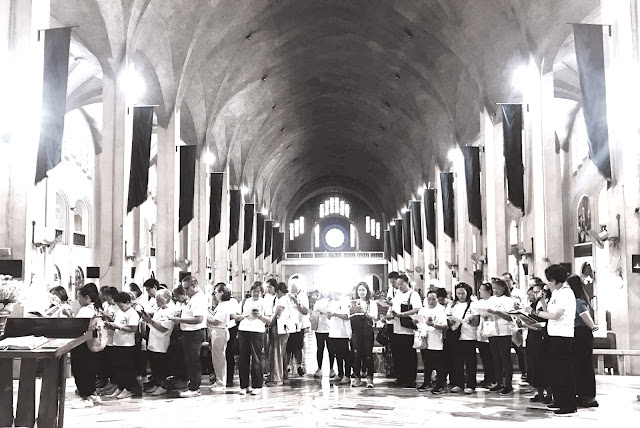























No comments:
Post a Comment